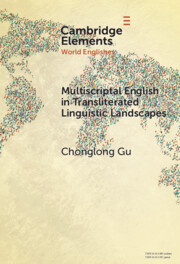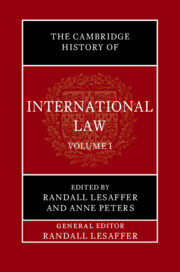202 results

Multiscriptal English in Transliterated Linguistic Landscapes
-
- Published online:
- 07 February 2025
- Print publication:
- 13 February 2025
-
- Element
- Export citation
Italian vermouth on the international market (1890–1960): a success story
-
- Journal:
- Modern Italy , First View
- Published online by Cambridge University Press:
- 23 January 2025, pp. 1-18
-
- Article
-
- You have access
- Open access
- HTML
- Export citation
Global distribution and sustainable management of Asian corn borer (ACB), Ostrinia furnacalis (Lepidoptera: Crambidae): recent advancement and future prospects
-
- Journal:
- Bulletin of Entomological Research / Volume 115 / Issue 1 / February 2025
- Published online by Cambridge University Press:
- 21 January 2025, pp. 105-120
-
- Article
- Export citation
Chapter 6 - Exploring diversity and communication
- from Part 2 - Communicating in organisations
-
- Book:
- Communication Skills for Business Professionals
- Published online:
- 25 February 2025
- Print publication:
- 15 January 2025, pp 131-162
-
- Chapter
- Export citation

The Cambridge History of International Law
-
- Published online:
- 06 December 2024
- Print publication:
- 21 November 2024
1 - Scope, Scale and Humility in the History of International Law
-
-
- Book:
- The Cambridge History of International Law
- Published online:
- 06 December 2024
- Print publication:
- 21 November 2024, pp 1-46
-
- Chapter
- Export citation
2 - A Thousand Flowers Blooming, or the Desert of the Real?
- from Part I - The Historiography of International Law
-
-
- Book:
- The Cambridge History of International Law
- Published online:
- 06 December 2024
- Print publication:
- 21 November 2024, pp 49-106
-
- Chapter
- Export citation
Effects of economic drivers on work health and safety in global supply chains: A discussion of the effectiveness of regulatory strategies and their economic contexts
-
- Journal:
- The Economic and Labour Relations Review / Volume 35 / Issue 3 / September 2024
- Published online by Cambridge University Press:
- 30 October 2024, pp. 556-575
-
- Article
-
- You have access
- Open access
- HTML
- Export citation
Chapter 2 - A teacher’s toolkit
- from Part 1 - Foundations
-
-
- Book:
- Understanding Sociological Theory for Educational Practices
- Published online:
- 14 November 2024
- Print publication:
- 21 October 2024, pp 28-44
-
- Chapter
- Export citation

An Introduction to International Relations
-
- Published online:
- 31 August 2024
- Print publication:
- 12 August 2024
-
- Textbook
- Export citation
Chapter 6 - Postmodernism
- from Part 1 - Theories of International Relations
-
-
- Book:
- An Introduction to International Relations
- Published online:
- 31 August 2024
- Print publication:
- 12 August 2024, pp 83-94
-
- Chapter
- Export citation
Chapter 20 - Non-state actors: A sociology of International Relations?
- from Part 4 - The new agenda: Globalisation and global challenges
-
-
- Book:
- An Introduction to International Relations
- Published online:
- 31 August 2024
- Print publication:
- 12 August 2024, pp 272-283
-
- Chapter
- Export citation
Chapter 12 - The modern state
- from Part 3 - The traditional agenda: States, wars and law
-
-
- Book:
- An Introduction to International Relations
- Published online:
- 31 August 2024
- Print publication:
- 12 August 2024, pp 168-180
-
- Chapter
- Export citation
Chapter 32 - Global public health
- from Part 4 - The new agenda: Globalisation and global challenges
-
-
- Book:
- An Introduction to International Relations
- Published online:
- 31 August 2024
- Print publication:
- 12 August 2024, pp 427-438
-
- Chapter
- Export citation
Chapter 21 - Religion and secularism
- from Part 4 - The new agenda: Globalisation and global challenges
-
-
- Book:
- An Introduction to International Relations
- Published online:
- 31 August 2024
- Print publication:
- 12 August 2024, pp 284-295
-
- Chapter
- Export citation
Chapter 25 - Globalisation and its critics
- from Part 4 - The new agenda: Globalisation and global challenges
-
-
- Book:
- An Introduction to International Relations
- Published online:
- 31 August 2024
- Print publication:
- 12 August 2024, pp 333-344
-
- Chapter
- Export citation
Chapter 18 - Diplomacy
- from Part 3 - The traditional agenda: States, wars and law
-
-
- Book:
- An Introduction to International Relations
- Published online:
- 31 August 2024
- Print publication:
- 12 August 2024, pp 245-257
-
- Chapter
- Export citation
Chapter 3 - The First 5000 Days
- from Section 1 - Mapping the field’s past
-
-
- Book:
- The Handbook of DOHaD and Society
- Published online:
- 20 June 2024
- Print publication:
- 27 June 2024, pp 44-56
-
- Chapter
-
- You have access
- Open access
- HTML
- Export citation
1 - A Diverse and Global Right
-
- Book:
- World of the Right
- Published online:
- 13 June 2024
- Print publication:
- 27 June 2024, pp 1-33
-
- Chapter
-
- You have access
- HTML
- Export citation
2 - The City as Multilingual Utopia
-
- Book:
- Speech and the City
- Published online:
- 23 May 2024
- Print publication:
- 30 May 2024, pp 19-40
-
- Chapter
- Export citation


